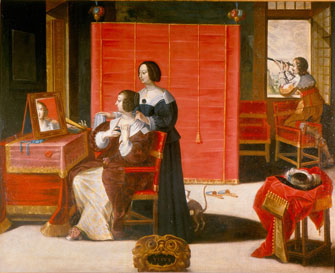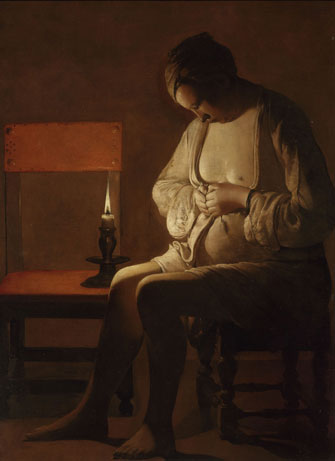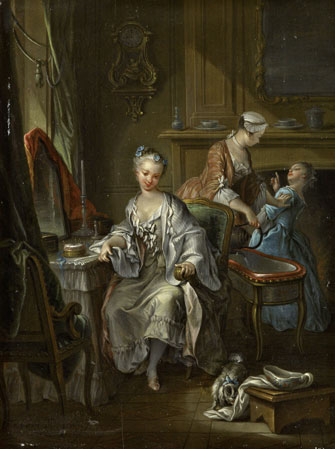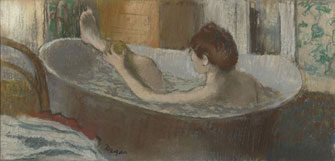A Private Moment
As Seen by the Artist

“La Vue (Femme à sa Toilette),” after Abraham Bosse. After 1635. © Tours, Musée des Beaux-Arts
The Musée Marmottan Monet’s latest exhibition, “La Toilette: The Invention of Privacy,” breaks away from the museum’s usual Impressionist fare, instead focusing on the history of everything to do with bathing and intimacy, from the early Renaissance to the present day. According to the catalogue, this is the first-ever exhibition on the subject, but what about the excellent “Le Bain et le Miroir” at the Musée de la Renaissance and the Musée Cluny in 2009?
Covering such a huge swath of ground in such a limited space is an ambitious undertaking, so it’s perhaps not surprising that the end result falls short. A few masterpieces make the visit worthwhile, but overall the exhibition is really only a taster, padded out, moreover, with a lot of mediocre art.
The show traces the history of cleansing rituals and the spaces and gestures dedicated to them as seen through the eyes of the artist. In more than 100 paintings, engravings, sculptures, prints, photographs and films, it immerses the visitor in what becomes, over time, a very private world.
The star piece is a sublime painting by Georges de la Tour, “Woman Catching a Flea.” It shows a servant girl squeezing a flea between her

“La Femme à la Puce” (1638), by Georges de La Tour © RMN-Grand Palais/Philippe Bernard
fingers, an earthy act given an otherworldly quality by de la Tour’s exquisite use of light.
The show starts with a fine tapestry from the Cluny Museum, dated 1500, depicting a young noblewoman taking a bath in an idyllic garden, surrounded by musicians, servants bearing tasty morsels and one carrying a casket of jewels. It depicts bathing as a stylized social, almost public ritual, a far cry, one suspects, from medieval realities.
Engravings by Albrecht Dürer follow, then paintings from the Fontainebleau School illustrating the late-16th-century vision of bathing in courtly circles.
A portrait by Nicolas Regnier of a young woman at her “toilette,” grooming herself before a mirror, is dated 1628. Here there is no sign of water or undress, rather a luxurious play of light and shade on her elaborate costume.
In the plague-ridden 17th century, water was widely feared as a transmitter of disease. Cloths, perfumes and ointments were the materials of purification, and cleansing was often a social activity.
With the passage of time, however, water began to play a role again in the business of washing, which became a more private affair. The footbath and bidet were invented in the 18th century.
A painting of a young woman at her toilette by Francois Eisen dated 1742 shows a bourdalou, a chamber pot adapted to a woman’s anatomy, named after the 17th-century preacher Bourdaloue, who gave such long sermons that women would bring chamber pots to put under

“Jeune Femme à sa Toilette” (1742), by François Eisen. © RMN-Grand Palais/Thierry Ollivier
their skirts (perhaps this, rather than Waterloo, was the source of the euphemism “loo”?). The painting also features a bidet, apparently still a novelty at the time.
By this time, women had their designated “boudoirs” and men their smoking rooms – often decorated with saucy paintings. A set of four paintings by François Boucher offers a good example: two innocent paintings, “The Docile Dog” and “The Spoiled Child” are covers for rather naughtier subjects, “The Raised Skirt” and “The Indiscreet Eye.”
In the next century, bathing took place in a very private area, while the classical ideal of the female form gave way to more realistic images of women rich with sensuality and

“Femme dans son Bain s’Epongeant la Jambe” (c. 1883), by Edgar Degas. © RMN-Grand Palais (Musée d’Orsay)/Hervé Lewandowski
life, exemplified in the paintings of Degas, Manet and Bonnard.
Moving on to the 20th century, there are representations of women at their dressing tables by artists such as Picasso and Fernand Léger. The current century is represented by images of women by contemporary photographers like Erwin Blumenfeld and Bettina Rheims. Why they were chosen over thousands of others is unclear.
The exhibition provides an interesting survey of the representation of female nudity and the female body through history, but it leaves the visitor not much the wiser.
Musée Marmottan Monet: 2, rue Louis-Boilly, 75016 Paris. Métro: La Muette. Open Tuesday-Sunday, 10am-6pm, until 9pm on Thursday. Closed Monday. Admission: €11. Through July 5, 2015. www.marmottan.fr
Reader reaction: Click here to respond to this article (your response may be published on this page and is subject to editing).
Please support Paris Update by ordering books from Paris Update’s Amazon store at no extra cost. Click on your preferred Amazon location: U.K., France, U.S.
More reviews of Paris art shows.
© 2015 Paris Update
Favorite